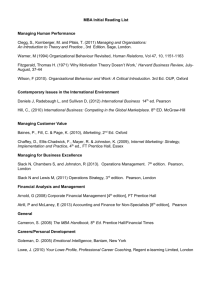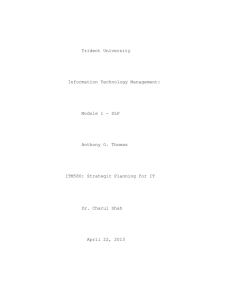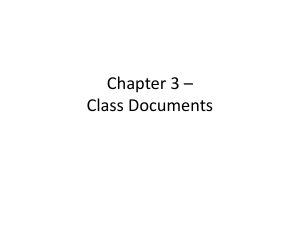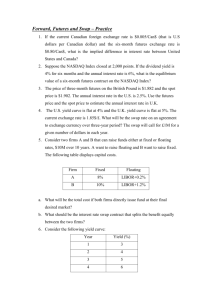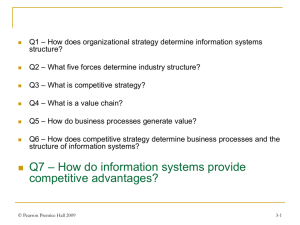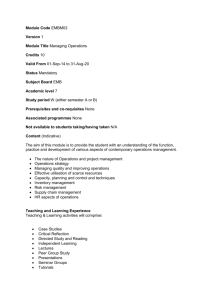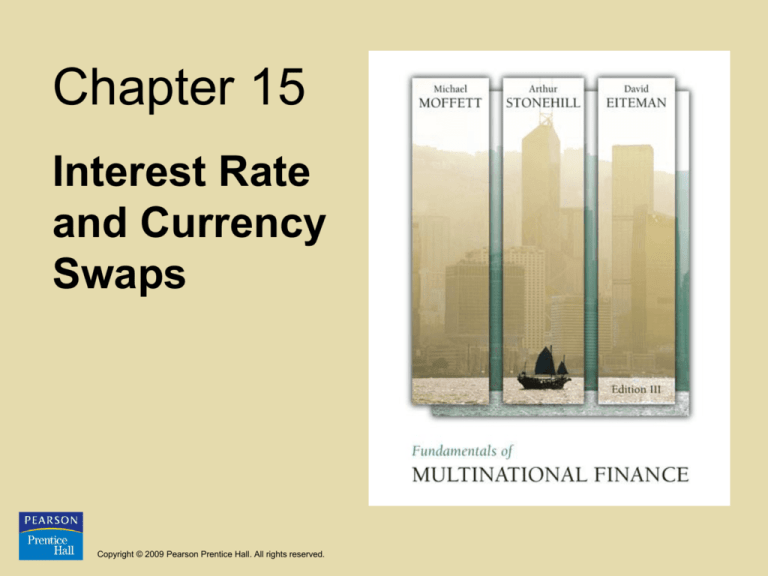
Chapter 15
Interest Rate
and Currency
Swaps
Copyright © 2009 Pearson Prentice Hall. All rights reserved.
Interest Rate & Currency Swaps:
Learning Objectives
• Define interest rate risk and demonstrate how it
can be managed
• Describe interest rate swaps and show how they
can be used to manage interest rate risk
• Analyze how interest rate swaps and crosscurrency swaps can be used to manage both
foreign exchange and interest rate risk
simultaneously
Copyright © 2009 Pearson Prentice Hall. All rights reserved.
15-2
Interest Rate Risk
• All firms, domestic or multinational, are sensitive to interest rate
movements
• The single largest interest rate risk of a non-financial firm is debt
service (for an MNE, differing currencies have differing interest
rates thus making this risk a larger concern – see exhibit)
• The second most prevalent source of interest rate risk is its
holding of interest sensitive securities
• Ever increasing competition has forced financial managers to
better manage both sides of the balance sheet
Copyright © 2009 Pearson Prentice Hall. All rights reserved.
15-3
Exhibit 15.1 International Interest
Rate Calculations
Copyright © 2009 Pearson Prentice Hall. All rights reserved.
15-4
Interest Rate Risk
• Whether it is on the left or right hand side, the
reference rate of interest calculation merits
special attention
– The reference rate is the rate of interest used in a
standardized quotation, loan agreement, or financial
derivative valuation
– Most common is LIBOR (London Interbank Offered
Rate)
Copyright © 2009 Pearson Prentice Hall. All rights reserved.
15-5
Exhibit 15.2 U.S. Dollar-Denominated
Interest Rates (February 2004)
Copyright © 2009 Pearson Prentice Hall. All rights reserved.
15-6
Credit and Repricing Risk
• Credit Risk or roll-over risk is the possibility
that a borrower’s creditworthiness at the time of
renewing a credit, is reclassified by the lender
– This can result in higher borrowing rates, fees, or
even denial
• Repricing risk is the risk of changes in interest
rates charged (earned) at the time a financial
contract’s rate is being reset
Copyright © 2009 Pearson Prentice Hall. All rights reserved.
15-7
Credit and Repricing Risk
• Example: Consider a firm facing three debt strategies
– Strategy #1: Borrow $1 million for 3 years at a fixed rate
– Strategy #2: Borrow $1 million for 3 years at a floating rate,
LIBOR + 2% to be reset annually
– Strategy #3: Borrow $1 million for 1 year at a fixed rate, then
renew the credit annually
• Although the lowest cost of funds is always a major
criteria, it is not the only one
Copyright © 2009 Pearson Prentice Hall. All rights reserved.
15-8
Credit and Repricing Risk
• Strategy #1 assures itself of funding at a known rate
for the three years; what is sacrificed is the ability to
enjoy a lower interest rate should rates fall over the
time period
• Strategy #2 offers what #1 didn’t, flexibility (repricing
risk). It too assures funding for the three years but
offers repricing risk when LIBOR changes
• Strategy #3 offers more flexibility and more risk; in the
second year the firm faces repricing and credit risk,
thus the funds are not guaranteed for the three years and
neither is the price
Copyright © 2009 Pearson Prentice Hall. All rights reserved.
15-9
Management of Interest Rate Risk
• The management dilemma is the balance between risk
and return
• Since most treasuries do not act as profit centers, their
management practices are typically conservative
• Before treasury can take any hedging strategy, it
must first form an expectation or a directional and/or
volatility view
• Once management has formed its expectations about
future interest rate levels and movements, it must then
choose the appropriate implementation of a strategy
Copyright © 2009 Pearson Prentice Hall. All rights reserved.
15-10
Exhibit 15.3
Treasury Policy Statements
Copyright © 2009 Pearson Prentice Hall. All rights reserved.
15-11
Trident’s Floating-Rate Loans
• Example using Trident corporation’s loan
of US$10 million serviced with annual payments and
the principal paid at the end
of the third year
– The loan is priced at US dollar LIBOR + 1.50%; LIBOR is
reset every year
– When the loan is drawn down initially (at time 0), an up-front
fee of 1.50% is charged
– Trident will not know the actual interest cost until the loan
has been completely repaid
Copyright © 2009 Pearson Prentice Hall. All rights reserved.
15-12
Exhibit 15.4 Trident Corporation’s
Costs and Cash Flows in Servicing a
Floating Rate Loan
Copyright © 2009 Pearson Prentice Hall. All rights reserved.
15-13
Trident’s Floating-Rate Loans
• If Trident had wished to manage the interest rate risk
associated with the loan, it would have a number of
alternatives
– Refinancing – Trident could go back to the lender and
refinance the entire agreement
– Forward Rate Agreements (FRAs) – Trident could lock in
the future interest rate payment in much the same way that
exchange rates are locked in with forward contracts
– Interest Rate Futures
– Interest Rate Swaps – Trident could swap the floating rate
note for a fixed rate note with a swap dealer
Copyright © 2009 Pearson Prentice Hall. All rights reserved.
15-14
Forward Rate Agreements (FRAs)
• A forward rate agreement is an interbank-traded
contract to buy or sell interest rate payments on a
notional principal
– Example: If Trident wished to lock in the first payment it
would buy an FRA which locks in a total interest payment at
6.50%
– If LIBOR rises above 5.00%, then Trident would receive a
cash payment from the FRA seller reducing their LIBOR
payment to 5.0%
– If LIBOR falls below 5.00% then Trident would pay the FRA
seller a cash amount increasing their LIBOR payment to
5.00%
Copyright © 2009 Pearson Prentice Hall. All rights reserved.
15-15
Interest Rate Futures
• Interest Rate futures are widely used; their popularity
stems from high liquidity of interest rate futures
markets, simplicity in use, and the rather standardized
interest rate exposures firms posses
• Traded on an exchange; two most common are the
Chicago Mercantile Exchange (CME) and the Chicago
Board of Trade (CBOT)
• The yield is calculated from the settlement price
– Example: March ’03 contract with settlement price of 94.76
gives an annual yield of 5.24% (100 – 94.76)
Copyright © 2009 Pearson Prentice Hall. All rights reserved.
15-16
Exhibit 15.5
Eurodollar Futures Prices
Copyright © 2009 Pearson Prentice Hall. All rights reserved.
15-17
Interest Rate Futures
• If Trident wanted to hedge a floating rate
payment due in March ’03 it would sell a futures
contract, or short the contract
– If interest rates rise, the futures price will fall and
Trident can offset its interest payment with the
proceeds from the sale of the futures contracts
– If interest rates rise, the futures price will rise and
the savings from the interest payment due will offset
the losses from the sale of the futures contracts
Copyright © 2009 Pearson Prentice Hall. All rights reserved.
15-18
Exhibit 15.6 Interest Rate Futures
Strategies for Common Exposures
Copyright © 2009 Pearson Prentice Hall. All rights reserved.
15-19
Interest Rate Swaps
• Swaps are contractual agreements to exchange or swap
a series of cash flows
• If the agreement is for one party to swap its fixed
interest payment for a floating rate payment, its is
termed an interest rate swap
• If the agreement is to swap currencies of debt service it
is termed a currency swap
• A single swap may combine elements of both interest
rate and currency swap
• The swap itself is not a source of capital but an
alteration of the cash flows associated with payment
Copyright © 2009 Pearson Prentice Hall. All rights reserved.
15-20
Interest Rate Swaps
• If firm thought that rates would rise it would enter into
a swap agreement to pay fixed and receive floating in
order to protect it from rising debt-service payments
• If firm thought that rates would fall it would enter into
a swap agreement to pay floating and receive fixed in
order to take advantage of lower debt-service payments
• The cash flows of an interest rate swap are interest rates
applied to a set amount of capital, no principal is
swapped only the coupon payments
Copyright © 2009 Pearson Prentice Hall. All rights reserved.
15-21
Exhibit 15.7 Interest Rate Swap
Strategies
Copyright © 2009 Pearson Prentice Hall. All rights reserved.
15-22
Comparative Advantage
• Companies of different credit quality are treated
differently by the capital markets
• For example, Unilever (U.K.) and Xerox (U.S.) are
both in the market for $30 million of debt for a fiveyear period
• Unilever is an AAA credit rating (the highest), and
therefore has access to both fixed and floating interest
rate debt at attractive rates
• Unilever would prefer to borrow at floating rates, since
it already has fixed-rate funds and wishes to increase
the proportion of its debt portfolio which is floating
Copyright © 2009 Pearson Prentice Hall. All rights reserved.
15-23
Comparative Advantage
• Xerox has a BBB credit rating (the lowest major
category of investment grade debt ratings), and would
prefer to raise the debt at fixed rates of interest
• Although Xerox has access to both fixed-rate and
floating-rate finds, the fixed-rate debt is considered
expensive
• The firms, through Citibank, could actually borrow in
their relatively ‘advantaged’ markets and then swap
their debt service payments
Copyright © 2009 Pearson Prentice Hall. All rights reserved.
15-24
Exhibit 15.8 Comparative Advantage
and Structuring a Swap Agreement
Copyright © 2009 Pearson Prentice Hall. All rights reserved.
15-25
Trident Corporation:
Swapping to Fixed Rates
• Maria Gonzalez (Trident’s CFO) is concerned about the
floating rate loan
– Maria thinks that rates will rise over the life of the loan and
wants to protect Trident from an increased interest payment
– Maria believes that an interest rate swap to pay fixed/receive
floating would be Trident’s best alternative
– Maria contacts the bank and receives a quote of 5.75%
against LIBOR; this means that Trident will receive LIBOR
and pay out 5.75% for the three years
Copyright © 2009 Pearson Prentice Hall. All rights reserved.
15-26
Trident Corporation: Swapping to
Fixed Rates
• The swap does not replace the original loan, Trident
must still make its payments at the original rates; the
swap only supplements the loan payments
• Trident’s 1.50% fixed rate above LIBOR must still be
paid along with the 5.75% as per the swap agreement;
however, Trident now receives LIBOR thus offsetting
the floating rate risk in the original loan
• Trident’s total payment will therefore be 7.25% (5.75%
+ 1.50%)
Copyright © 2009 Pearson Prentice Hall. All rights reserved.
15-27
Exhibit 15.9 Trident Corporation’s
Interest Rate Swap to Pay Fixed/Receive
Floating
Copyright © 2009 Pearson Prentice Hall. All rights reserved.
15-28
Trident Corp: Swapping Dollars into
Swiss francs
• After raising the $10 million in floating rate financing
and swapping into fixed rate payments, Trident decides
it would prefer to make its debt-service payments in
Swiss francs
– Trident signed a 3-year contract with a Swiss buyer, thus
providing a stream of cash flows in Swiss francs
• Trident would now enter into a three-year pay Swiss
francs and receive US dollars currency swap
– Both interest rates are fixed
– Trident will pay 2.01% (ask rate) fixed Sfr interest and
receive 5.56% (bid rate) fixed US dollars
Copyright © 2009 Pearson Prentice Hall. All rights reserved.
15-29
Exhibit 15.10 Interest Rate and
Currency Swap Quotes
Copyright © 2009 Pearson Prentice Hall. All rights reserved.
15-30
Trident Corp: Swapping Dollars into
Swiss francs
• The spot rate in effect on the date of the agreement
establishes what the notional principal is in the target
currency
– In this case, Trident is swapping into francs, at Sfr1.50/$.
– This is a notional amount of Sfr15,000,000. Thus Trident is
committing to payments of Sfr301,500 (2.01%
Sfr15,000,000 = Sfr301,500)
– Unlike an interest rate swap, the notional amounts are part of
the swap agreement
Copyright © 2009 Pearson Prentice Hall. All rights reserved.
15-31
Exhibit 15.11 Trident Corporation’s
Currency Swap: Pay Swiss Francs and
Receive U.S. Dollars
Copyright © 2009 Pearson Prentice Hall. All rights reserved.
15-32
Trident Corporation:
Unwinding Swaps
• As with the original loan agreement, a swap can be
entered or unwound if viewpoints change or other
developments occur
• Assume that the three-year contract with the Swiss
buyer terminates after one year, Trident no longer needs
the currency swap
• Unwinding a currency swap requires the discounting of
the remaining cash flows under the swap agreement at
current interest rates then converting the target currency
back to the home currency
Copyright © 2009 Pearson Prentice Hall. All rights reserved.
15-33
Trident Corporation:
Unwinding Swaps
• If Trident has two payments of Sfr301,500 and
Sfr15,301,500 remaining (interest plus principal
in year three) and the 2 year fixed rate for francs
is now 2.00%, the PV of Trident’s commitment
is francs is
Sfr301,500 Sfr15,301, 500
PV(Sfr)
Sfr15,002, 912
1
2
(1.020)
(1.020)
Copyright © 2009 Pearson Prentice Hall. All rights reserved.
15-34
Trident Corporation:
Unwinding Swaps
• At the same time, the PV of the remaining cash
flows on the dollar-side of the swap is
determined using the current 2 year fixed dollar
rate which is now 5.50%
$556,000 $10,556,000
PV(US$)
$10,011,078
1
2
(1.055)
(1.055)
Copyright © 2009 Pearson Prentice Hall. All rights reserved.
15-35
Trident Corporation:
Unwinding Swaps
• Trident’s currency swap, if unwound now, would yield
a PV of net inflows of $10,011,078 and a PV of net
outflows of Sfr15,002,912. If the current spot rate is
Sfr1.4650/$ the net settlement of the swap is
Sfr15,002, 912
Settlement $10,011,078
($229,818)
Sfr1.4650/ $
• Trident makes a cash payment to the swap dealer of
$229,818 to terminate the swap
– Trident lost on the swap due to franc appreciation
Copyright © 2009 Pearson Prentice Hall. All rights reserved.
15-36
Counterparty Risk
• Counterparty Risk is the potential exposure any
individual firm bears that the second party to any
financial contract will be unable to fulfill its obligations
• A firm entering into a swap agreement retains the
ultimate responsibility for its debt-service
• In the event that a swap counterpart defaults, the
payments would cease and the losses associated with
the failed swap would be mitigated
• The real exposure in a swap is not the total notional
principal but the mark-to-market value of the
differentials
Copyright © 2009 Pearson Prentice Hall. All rights reserved.
15-37
A Three-way Cross Currency Swap
• Sometimes firms enter into loan agreements with a
swap already in mind, thus creating a debt issuance
coupled with a swap from its inception
– Example: the Finnish Export Credit agency (FEC), the
Province of Ontario, Canada and the Inter-American
Development Bank (IADB) all possessed access to ready
sources capital but wished debt service in another market
– FEC had not raised capital in Canadian dollar Euromarkets
and an issuance would be well received; however the FEC
had a need for increased debt-service in US dollars, not
Canadian dollars
Copyright © 2009 Pearson Prentice Hall. All rights reserved.
15-38
A Three-way Cross Currency Swap
– Province of Ontario needed Canadian dollars but due to size
of provincial borrowings knew that issues would push up its
cost of funds; there was however an attractive market in US
dollars
– IADB had a need for additional US dollar denominated debtservice; however it already raised most of its debt in the US
markets but was a welcome newcomer in the Canadian dollar
market
• Each borrower determined its initial debt amounts and
maturities expressly with the needs of the swap
Copyright © 2009 Pearson Prentice Hall. All rights reserved.
15-39
Exhibit 15.12 A Three-Way
Back-to-Back Cross-Currency Swap
Copyright © 2009 Pearson Prentice Hall. All rights reserved.
15-40
Summary of Learning Objectives
• The single largest interest rate risk of the non-financial
firm is debt-service. The debt structure of an MNE will
possess differing maturities of debt, different interest
rates and different currency denominations
• The increasing volatility of world interest rates,
combined with increasing use of short-term and
variable-rate notes has led many firms to actively
manage their interest rate risk
Copyright © 2009 Pearson Prentice Hall. All rights reserved.
15-41
Summary of Learning Objectives
• The primary sources of interest rate risk to an MNE are
short-term borrowing and investing and long-term
borrowing
• The techniques and instruments used in interest rate
risk management resemble those used in currency risk
management: the old method of lending and borrowing
• The primary instruments include forward rate
agreements (FRAs), interest rate futures, forward swaps
and interest rate swaps
Copyright © 2009 Pearson Prentice Hall. All rights reserved.
15-42
Summary of Learning Objectives
• The interest rate and currency swap markets
allow firms that have limited access to specific
currencies and interest rate structures to gain
access at relatively low costs
• A cross currency interest rate swap allows a firm
to alter both the currency of denomination of the
cash flows but also to alter the fixed-to-floating
or floating-to-fixed interest rate structure
Copyright © 2009 Pearson Prentice Hall. All rights reserved.
15-43

